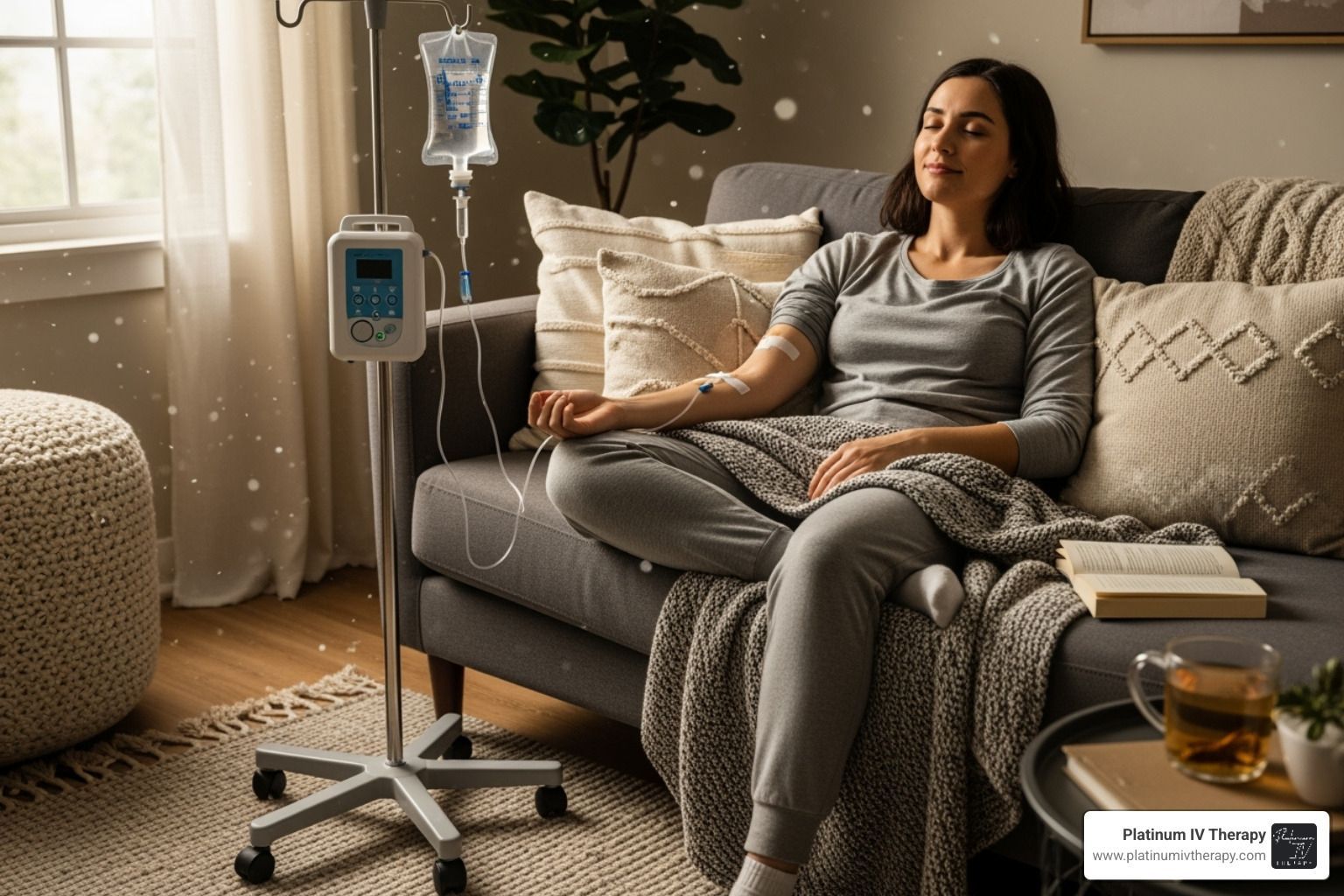IV Antibiotics Side Effects: What’s Normal, What’s Not, and How We Can Help
IV antibiotics side effects are an expected part of many treatment plans. This guide clarifies what’s typical vs. concerning, how timelines usually progress, and the moments that warrant a call to your clinician—so you can navigate therapy with clear expectations.
At Platinum IV Therapy, we make sure the IV part of your wellness journey is safe, comfortable, and convenient. Our licensed nurses bring hydration and nutrient blends right to your home, office, or hotel across Maricopa and Pinal Counties. Explore our IV Packages and see how we can support you while your prescribed treatment does its work.
Why Do Clinicians Choose IV Antibiotics?
When doctors recommend IV antibiotics, it’s usually because the situation calls for fast, reliable, and powerful treatment. Common reasons include:
- Serious infections in the lungs, heart, brain, or bones where quick action is critical.
- When oral antibiotics aren’t an option—such as persistent vomiting, swallowing difficulties, or absorption problems.
- Resistant bacteria that don’t respond well to pills and require stronger IV-only medications.
- High-dose needs that can’t safely or effectively be managed with tablets or liquids.
- Longer treatment plans, often starting in the hospital and continuing at home through OPAT (Outpatient Parenteral Antimicrobial Therapy) with regular monitoring.
These situations are exactly why clinicians turn to IV therapy: it delivers medicine directly into your bloodstream for reliable results, while keeping patient safety and outcomes front and center.
What Are the Most Common IV Antibiotics Side Effects?
Most people notice mild, short-term symptoms that fade as treatment ends. The most common IV antibiotics side effects include:
- Upset stomach — nausea, occasional vomiting, or loose stools.
- Skin changes — light, patchy rash or itching.
- Headache or dizziness — usually brief and self-limited.
- Metallic / altered taste — temporary taste changes during therapy.
- Yeast overgrowth — oral thrush (white mouth patches) or vaginal yeast infections (itching, discharge).
- Infusion-site irritation (phlebitis) — tenderness, warmth, redness, or a mild “cord-like” vein; commonly settles in 1–2 weeks.
When to call your clinician
- Diarrhea that’s severe, bloody, or lasts more than 1–2 days—especially with fever or abdominal pain (possible antibiotic-associated diarrhea or C. difficile).
- Any side effect that worsens, doesn’t improve, or feels concerning to you.
Which IV Antibiotics Side Effects Need Faster Attention?
While most IV antibiotics side effects are mild, a few can signal something more serious. These reactions should never be ignored and require immediate medical attention:
- Allergic reactions
Watch for hives, wheezing, swelling of the lips, face, or tongue, or trouble breathing. These may indicate a serious allergy (for example, reactions linked with cephalosporins like ceftriaxone). Seek urgent care right away.
- Severe diarrhea or C. difficile infection
If you develop watery diarrhea with stomach cramps, fever, or persistent symptoms during or after antibiotic treatment, it may point to Clostridioides difficile (C. diff). This requires prompt testing and treatment.
- Infusion reactions
Some antibiotics (such as vancomycin) can trigger flushing, itching, chest or back discomfort, lightheadedness, or low blood pressure during the drip. Clinicians often manage this by pausing or slowing the infusion, but you should report these symptoms immediately.
- Tendon, nerve, or heart concerns
Certain antibiotics like fluoroquinolones carry rare but serious risks. Warning signs include new tendon pain, numbness, tingling, muscle weakness, palpitations, fainting, or severe chest/back/abdominal pain. Report these right away, as the FDA notes they may be linked to nerve damage, tendon rupture, or heart complications.
How Long Do IV Antibiotics Side Effects Last?
Side-effect timelines aren’t one-size-fits-all—drug type, dose, length of therapy, and your health history all play a role. Here’s a reader-friendly guide you can skim:
The quick timeline
- Upset stomach (nausea, mild diarrhea, vomiting): often eases within 24–72 hours after a dose and usually settles a few days after finishing treatment.
- Headache, dizziness, metallic/altered taste: typically fade within days once therapy stops.
- Mild rash or itching: may resolve over several days to 1–2 weeks. Get urgent care for hives, swelling, wheeze, or trouble breathing.
- Infusion-site irritation (phlebitis): soreness/redness or a “cord-like” vein usually calms in 1–2 weeks as the vein heals.
- Antibiotic-associated diarrhea / possible C. diff: can begin during treatment or weeks later—seek care if severe or persistent, or if there’s fever or abdominal pain.
Why some IV antibiotics side effects last longer
- Longer courses / higher doses → more cumulative irritation.
- Kidney or liver function → slower clearance can prolong symptoms.
- Other medications & interactions → can amplify dizziness, GI upset, or rhythm sensitivity.
- History of gut issues (incl. prior C. diff) → diarrhea may take longer to settle.
- Line type & infusion rate →PICC/midlineand faster drips may add temporary site discomfort.
How Platinum IV Therapy Helps With IV Antibiotics Side Effects

Dealing with IV antibiotics side effects can leave you feeling worn out—nausea, dehydration, low energy, or discomfort at the IV site are all common. At Platinum IV Therapy, our goal is to make recovery a little easier by offering wellness-focused IV options that support your comfort alongside your prescribed treatment plan.
Supportive ways we help:
- Hydration IVs – When fever, appetite loss, nausea, or GI upset leaves you drained, our IV Packages focus on rehydration and balance. With options that can include anti-nausea support, these drips help you feel steadier and more comfortable while you manage IV antibiotics side effects.
- Custom Add-Ons – Side effects like queasiness or fatigue can sometimes be eased with options such as anti-nausea support, magnesium, or glutathione. Our Add-Ons allow you to personalize your wellness IV under your clinician’s guidance.
- Care at your convenience – Whether you’re at home, work, or even a hotel, our licensed nurses bring care directly to you. That means you can stay comfortable while managing IV antibiotics side effects without extra stress.
- Trusted guidance – Not sure what to choose? Our resources help you understand what to look for in safe mobile IV services.
A gentle reminder
Wellness IVs from Platinum IV Therapy are designed to support your recovery but they do not replace antibiotics. Always follow your clinician’s plan, and think of us as your partner in making the journey feel more manageable.











